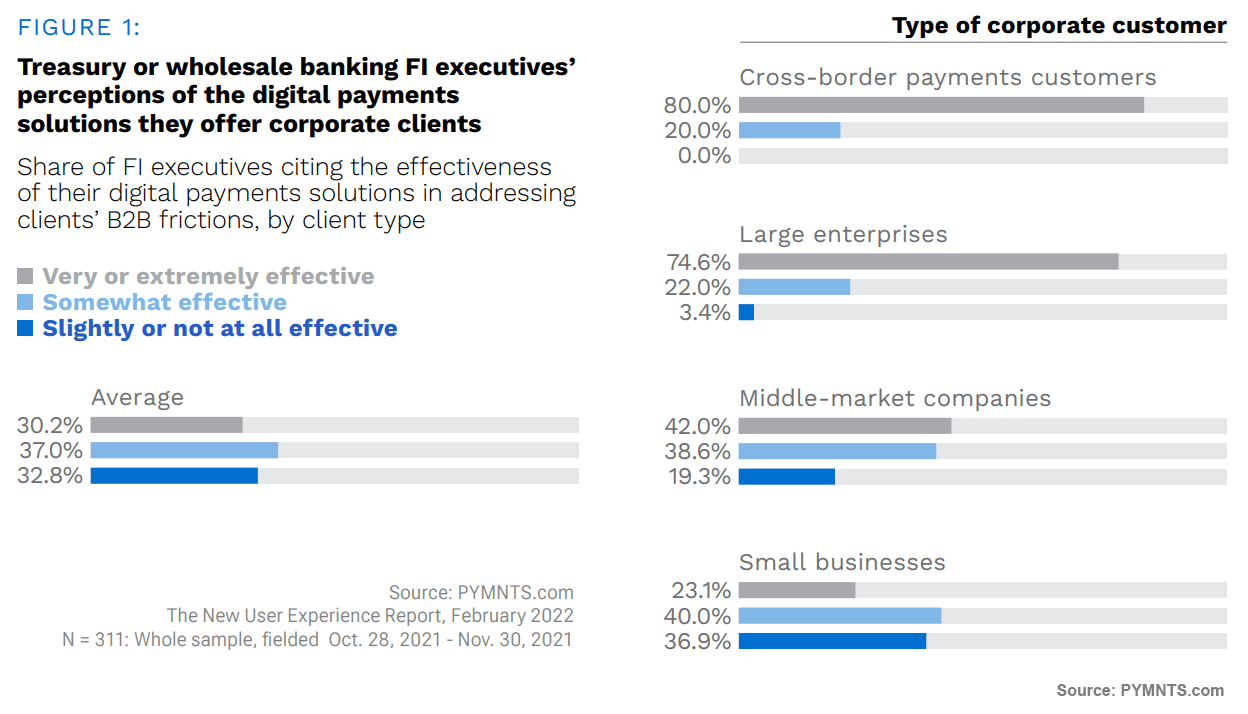
Efforts to modernize and speed up the B2B cross-border payment experience have lagged similar efforts to improve the online payment experience for consumers, resulting in processes that are often complicated and filled with friction.
For small and midsize businesses (SMBs), they’re often prohibitively so. In fact, 27% of them rank the complexity of making cross-border payments as one of their top obstacles.
And the financial institutions serving them are all too aware of this fact. Data from the August and September B2B Payments Tracker, a PYMNTS and American Express collaboration, shows that their bankers grow less and less satisfied with their own digital payment solutions as the size of the client decreases. For large enterprises, 74% of respondents were very or extremely satisfied with the solutions offered, while this percentage dropped to 23% for small businesses.

Get the Report: B2B Cross-Border Payments Tracker
It is also worth noting that for cross-border payments, around 80% of respondents said they were very satisfied with their solutions, despite the challenges for this type of payment.
Another difficulty in cross-border payments revolves around interoperability and application programming interfaces (APIs). To make payments across borders, information must be shared across different payment networks and systems. APIs are one of the best ways to accomplish this communication, which is why a striking 65% of payment operators currently use APIs and another 20% plan to.
API or no API, however, networks and systems can communicate with each other only if they are interoperable. This means they must share the same protocols, formats, and other aspects that allow a message from one network to be understood by the other.
At present, there is a distinct lack of interoperability and standardization, with only 38% of payment system operators reporting the existence of domestic standards for APIs. Nearly 8 in 10 of them view this lack of standardization as the biggest barrier to API adoption.
Without this adoption, cross-border payments will remain challenging.
Transparency is Job 1
In addition to interoperability, transparency is an important consideration for B2B cross-border payments. A lack of transparency can result in friction in both the payment process and communication between providers, firms, and end customers.
This is especially important in industries, such as healthcare and insurance, where transactions can involve multiple entities. One of the best ways to improve transparency is to digitize the payment process, as many companies have already done or plan to do.
A recent PYMNTS survey found that 56% of companies with plans to digitize their payment operations view making the payment process more transparent as an important outcome.
Of the surveyed companies that had accelerated their digitization efforts, a striking 35% reported doing so to provide their vendors and customers with a more transparent process. This rush to digitize is understandable because once completed, payments digitization can have a tremendous impact. Of the companies that had already digitized payments, 60% said those projects had a positive impact on supplier relationships
Solutions to the Rescue
According to PYMNTS’ data, the most common solution financial institutions (FIs) currently provide to reduce B2B payments friction is automated account validation, so FIs not currently offering this product should consider doing so.
Faster or real-time payment functionality should be another consideration. The ideal cross-border digital solution should be easy to use and provide customers with important details such as transparent exchange rates and payment delivery dates.
If FIs can provide the right solutions, businesses will benefit in a variety of ways. For example, 64% of U.S. SMBs view reduced fraud risk as the biggest benefit of cross-border payments innovation.
PYMNTS’ data also shows that 56% of overall U.S. businesses view enhanced cash management capabilities as a benefit of cross-border payment solutions.
They also believe innovation would reduce errors, improve accounts receivable (AR) efficiency, and provide access to a range of new products and services. With all these benefits, it is no surprise that business customers are increasingly seeking cross-border payments solutions. It is now up to FIs to provide them.